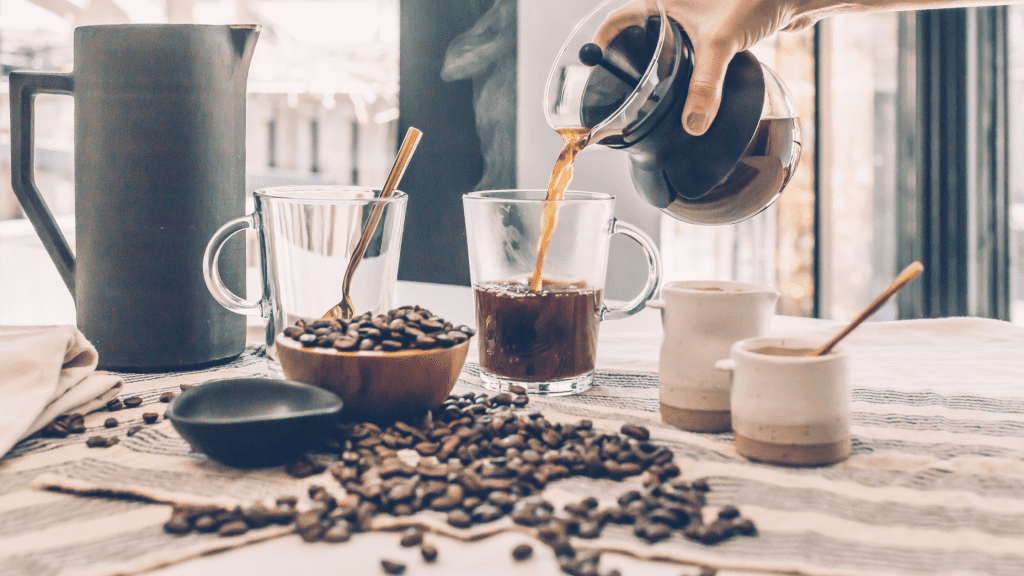
Roasting coffee beans to perfection is an art that takes a lot of practice to master. It’s pretty simple; you won’t get the richer taste if you roast the beans too little, and you will get a burned taste if you roast them too long.
However, once in a while, dark roast lovers will find some dark and shiny beans in their trays. They are popularly known as oily beans. But where does that oil come from?
Simply put, when the beans are over-roasted, the coffee oil seeps out, giving them a dark and shiny appearance.
Is this oil harmful? Can you still have coffee roasted using oily beans? Keep reading to get all the answers.
Why do Coffee Beans Get Oily?
Table of Contents
To start with, I would like to bust a myth many believe. There is no relation between a coffee bean’s freshness and its oiliness. Many think the more oily the beans, the fresher they are, and dry beans signify old or stale beans. But it’s completely wrong.
The oiliness of the coffee beans depends on how they have been roasted. Looking closely at a coffee bean’s anatomy, we will find its second most internal layer, the endosperm. This is the most important layer containing all the aromas.
The chemical composition of this layer has two types of contents that are soluble and insoluble in water. In case of roasting the beans too much, the outer layer of endosperm breaks, and the water-insoluble (the “oil”) components seep out.
To get the perfect batch of dark roast beans, you need to roast the coffee seeds for 8-9 minutes at 240°C (464°F). If you overdo this, a chemical reaction happens in the endosperm of the beans, and they crack open, letting out the oils.
For different coffee beans, the roasting temperature stays constant. But whether you want light, medium, or dark roast, the roasting timespan will change.
So the answer to why coffee beans get oily is that you are roasting them for too long. And this is also the reason why you wouldn’t find oily beans in case of light or medium roasts.
Do Oily Beans Affect The Taste Of The Coffee?
Yes, the oils in the coffee beans influence the taste of your perfect espresso, depending on where the oil is.
By that, I mean that if the oil is trapped inside the beans, which is usually the case for light to medium roasts, you will find a sweeter and less intense flavor of the coffee. Coffee enthusiasts call this the ‘original’ flavor because it’s untampered by over-roasting.
On the other hand, when the oil seeps out on the surface of the beans due to over-roasting, it becomes more bitter and smoky. It is because the oil gets oxidated by reacting with the oxygen in the air and changes the flavor complexities.
Therefore, the flavor of oily beans is definitely different from dry coffee beans. But whether the flavor gets better or worse varies since everyone has a different definition of good coffee.
Are Oily Coffee Beans Good or Bad?
The oils on the coffee beans are the melted lipids (fat) stored inside the bean, meaning it is a plant-based fat and not something that will harm your health.
But on the other hand, the fat stores all the aroma. So, it is better not to let it out. As soon as the aromatic components come in contact with the air, you’ll start losing the flavor of the coffee and will be left with some bitter beans devoid of scent.
Besides, oily beans are more likely to get stale than dry beans. Hence, you will also struggle to store the beans for a long time.
So while oily coffee beans might not harm your health, they will also not quench your thirst for that perfect sip of coffee.
Are Oily Coffee Beans Bad For Your Grinder?
When the beans are ground separately before brewing, it isn’t worth worrying about. However, this oiliness can cause problems if you own a bean-to-cup system.
Oily coffee beans may not harm your health, but they will definitely harm your grinder! So if you want your coffee grinder to last long, keep reading.
Here are the top three reasons to avoid putting oily coffee beans in your precious coffee grinder.
1. Oily Coffee Beans Are Hard To Grind
When you grind normal coffee beans, the coffee grounds are more powdery in consistency. But when you grind oily beans, the results are different.
If you grind oily coffee beans, the oils cause the grains to stick together, resulting in a clay-like texture. If you have a blade grinder, this will make it harder for the blades to move properly.
2. The Coffee Oil Will Clog The Grinder
When the coffee grounds become sticky, they increase the chances of your grinder getting clogged. The sticky grounds often solidify into small coffee chunks that can get stuck in the filter basket.
The discharge chute will get blocked if you have an automatic coffee maker. This will result in the coffee not coming out of the machine at all.
3. The Burr Chamber Will Become Sticky
The oils released from the beans will eventually settle on the walls of the burr chamber, making it all sticky. So even if you use dry coffee beans next time. The grind will again get stuck on the chamber’s wall.
This way, the build-up will continue, and your expensive burr grinder will stop functioning properly.
How to Clean Your Oily Coffee Grinder?
Cleaning your grinder occasionally ensures that the device works effectively in the long run. So here are the two ways in which you can clean different coffee grinders.
1. Cleaning A Blade Coffee Grinder
- First, fill the grinder with uncooked rice until the blades are fully covered.
- Turn on the grinder and let it run for 60 to 90 secs so that the rice can collect all the oil stuck on the blades.
- Empty the rice out of the grinder.
- Add in the same fresh rice and repeat until all the oil is absorbed.
- Empty out the last batch and wipe the interior with a dry cloth.
- Unplug the grinder and use a damp towel to wipe the inside thoroughly.
- Finally, use another dry paper towel to clean it dry.
2. Cleaning A Burr Coffee Grinder
Cleaning a burr grinder is comparatively trickier than a blade one. But here’s how you can do it easily at home.
- First, unplug the grinder and remove the bean hopper. Once the hopper is removed, you can empty it and clean it with soap and water.
- Now carefully remove all the removable plastic and rubber pieces and the grinding chamber and wash them with soapy water.
- Using a screwdriver, remove the inner burr.
- Once the inner burr is removed, scrub it with a brush. Use something with stiff bristles like a toothbrush and remove any coffee ground sticking on the nooks and crannies.
- After scrubbing, wipe down the burrs with a damp towel.
- Then clean the coffee chute with a cotton swab.
- Let all the parts dry completely before reassembling them to avoid rusting.
How To Save Your Coffee Beans From Getting Oily?
To save yourself the hassle of cleaning the grinder and coffee maker, these are the things you can do and save your coffee beans from getting oily.
1. Store The Beans In A Cold And Dry Place
Storing the beans in a cold and dry place will ensure that the natural oil inside them does not seep out. Keeping the beans in hot weather will make the oil come out automatically, even if you only roast them for a short time.
You can keep them in the refrigerator, but there are better options than that. If you don’t put them in an airtight container, the coffee beans may absorb the odor of other food items and lose their aroma.
2. Buy a Fresh Batch Of Beans
Try to buy coffee beans that have been roasted for at most 2.5 weeks. It is assumed that 5 weeks after the roasting, the beans start releasing some oil. That can be due to the way they were stored or many other reasons.
Freshly roasted beans are less oxidized. So it is best to buy freshly roasted beans. Instead of store-bought beans, you can look for local coffee roasters.
3. Buy Lighter Roast Beans
Lightly roasted beans are roasted for a lesser duration. So the lipids don’t get much drawn to the surface. This means the beans will naturally be less oily compared to dark roasts.
If you are a regular drinker of dark roast, shifting to a light roast will take a toll on your tastebuds. You can take medium roasts in more than the usual amount. This will help you achieve the strong flavor that you are accustomed to.
Can You Dry Oily Coffee Beans?
To be honest, you can’t dry coffee beans that are already oily. The deed is done, and the lipid inside the beans has already risen to the surface. There’s no way you can put the oils back.
Since that oil has all the aromatic goodness, removing the glossy layer from the beans will only make them bland.
Instead of tossing them into the bin, the best thing you can do is mix them with a lighter batch of coffee. In that way, the oiliness will get balanced to some extent, and your grinder won’t get dirty either.
But the worst thing you can do is rinse them with water! Just DON’T do it. You would just wash off the oils and the little scent left in them.
What Are Some Other Ways Of Using Your Oily Coffee Beans?
If you want to avoid drinking oily coffee, then these are the best ways to repurpose them in an environment-friendly manner.
1. Use As A Fertilizer
Grind the coffee beans in a separate grinder and mix them with the garden compost or soil mix used for the plants. The beans will help to detach the heavy metals from the water and improve the quality of the soil.
2. Make A Body Scrub
Ground the beans finely and mix them with honey to make the best homemade body scrub. Avoid if you have sensitive skin.
3. Keep The Ants Away
Ants hate coffee. So if ants are bugging you, scatter some coffee grounds, and your problem will be solved.
Final Thoughts
Oily beans are neither rancid nor fresh. Oil on the beans means they have been roasted for too long. You can still drink them if you like a bitter and bold taste. But avoid putting them in your fancy all-in-one grinder and coffee maker.
FAQ
Q1. How To Tell If Coffee Beans Are Oily?
Oil coffee beans look and feel greasy, and if you take some of them in your hand, you will notice an oily residue. Also, the coffee brewed with these beans will be extremely dark, which is another sign of oil.
Q2. Are Coffee Beans Supposed To Be Oily?
Coffee beans contain oil. Over time and sometimes due to over-roasting, the oils come out on the surface. So oily beans are a natural thing. But it would be best to buy beans that look glossy but aren’t oily.
Q3: Which Coffee Beans Get Oily?
Every kind of coffee bean can get oily since all beans contain natural oil in them. However, certain kinds get oily very easily. Such varieties include Old brown java, kopi luwak, continental, monsoon Malabar, etc.



